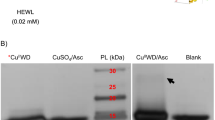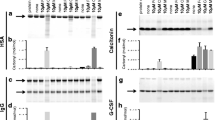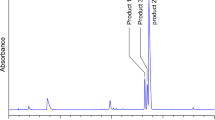Abstract
Purpose. Site-specific protein oxidation induced by prooxidant/metal/ oxygen has been recognized as one of the major degradation pathways of protein pharmaceuticals. Polyaminocarboxylate (PAC) metal chelators are commonly employed to prevent metal-catalyzed oxidation, for they sequester metals. However, studies have indicated that iron chelates may still be catalytically active due to their specific coordination geometry. The purpose of this study was to investigate how PAC chelators affect prooxidant/metal/oxygen-catalyzed oxidation of peptides containing histidine (His) and methionine (Met).
Methods. PACs were applied to a model oxidizing system, dithiothreitol/iron/oxygen, which was shown to promote the oxidation of Met to Met sulfoxide in the two model peptides, GGGMGGG and GHGMGGG.
Results. PAC chelators did not suppress the peptide oxidation but significantly changed the product pattern. In particular, the yield of Met sulfoxide dropped significantly, while a number of other products emerged, including oxidation products from the N-terminus and His (if present). Overall, the oxidation became rather non-selective in the presence of PACs. The oxidation kinetics were significantly accelerated by nitrilotriacetate (NTA), ethylenediaminediacetate (HDDA), and ethylenediaminetetraacetate (EDTA), but they were slowed down by ethyl-enebis(oxyethylenenitrilo)tetraacetate (EGTA) and diethylenetriaminepentaacetate (DTPA). Meanwhile the PAC chelators were also observed to undergo degradation. Scavengers of hydrogen peroxide or hydroxyl radicals exerted only partial inhibition on the peptide oxidation.
Conclusions. The results of this study are rationalized by the abilities of PAC chelators (i) to extract iron from potential binding sites of the peptides to impair site-specific oxidation, and (ii) to promote the formation of ROS different from the species formed at the peptide metal-binding sites.
Similar content being viewed by others
REFERENCES
E. R. Stadtman. Oxidation of free amino acids and amino acid residues in proteins by radiolysis and by metal-catalyzed reactions. Annu. Rev. Biochem. 62:797–821 (1993).
E. R. Stadtman and C. N. Oliver. Metal-catalyzed oxidation of proteins. J. Biol. Chem. 266:2005–2008 (1991).
E. R. Stadtman. Metal-ion catalyzed oxidation of proteins: Biochemical mechanism and biological consequences. Free Rad. Biol. Med. 9:315–325 (1990).
M. C. Manning, K. Patel, and R. T. Borchardt. Stability of protein pharmaceuticals. Pharm. Res. 6:903–918 (1989).
W. Vogt. Oxidation of methionyl residues in proteins: tools, targets, and reversal. Free Rad. Biol. Med. 18:93–105 (1995).
S. Li, T. Nguyen, C. Schöneich, and R. T. Borchardt. Aggregation and precipitation of human relaxin induced by metal-catalyzed oxidation. Biochemistry 34:5762–5772 (1995).
R. Pearlman and T. Nguyen. Pharmaceutics of protein drugs. J. Pharm. Pharmacol. 44(suppl.1):178–185 (1992).
G. W. Becker, P. M. Tackitt, W. W. Bromer, D. S. Lefeber, and R. M. Riggin. Isolation and characterization of a sulfoxide and a desamido derivative of biosynthetic human growth hormone. Biotechnol. Appl. Biochem. 10:326–337 (1988).
B. C. Cunningham, M. G. Mulkerrin, J. A. Wells. Dimerization of human growth hormone by zinc. Science 253:545–548 (1991).
Ch. Schöneich, F. Zhao, G. S. Wilson, and R. T. Borchardt. Ironthiolate induced oxidation of methionine to methionine sulfoxide in small model peptides. Intramolecular catalysis by histidine. Biochim. Biophys. Acta 1158:307–322 (1993).
E. Atherton and R. C. Sheppard. Solid phase peptide synthesis. A practical approach. IRL Press at Oxford University Press. 1989.
G. A. Elgavish and J. Granot. Enhancement of 31P relaxation rates of orthophosphate and ATP in the presence of EDTA. Evidence for EDTA-Fe(III)-phosphate ternary complexes. J. Magn. Reson. 36:147–150 (1979).
M. Deacon, M. R. Smyth, and L. G. M. T. Tuinstra. Chromatographic separations of metal chelates present in commercial fertilizers. II. Development of an ion-pair chromatographic separation for the simultaneous determination of Fe(III) chelates of EDTA, DTPA, HEEDTA, EDDHA and EDDHMA, and the Cu(II), Zn(II) and Mn(II) chelates of EDTA. J. Chromatog. A 659:349–357 (1994).
M. S. Akhlaq and C. v. Sonntag. Free-radical-induced elimination of H2S from dithiothreitol. A chain reaction. J. Am. Chem. Soc. 108:3542–3544 (1986).
K. Uchida and S. Kawakishi. Selective oxidation of imidazole ring in histidine residues by the ascorbic acid-copper ion system. Biochem. Biophys. Res. Commun. 138:659–665 (1986).
R. L. Levine. Oxidation modification of glutamine synthase. J. Biol. Chem. 258:11823–11827 (1983).
R. T. Dean, S. P. Wolff, and M. A. McElligott. Histidine and proline are important sites of free radical damage to proteins. Free Rad. Res. Comms. 7:97–103 (1989).
W. M. Garrison. Reaction mechanisms in the radiolysis of peptides, polypeptides, and proteins. Chem. Rev. 87:381–398 (1987).
K. C. Francis, D. Cummins and J. Oakes. Kinetics and structural investigations of [FeIII(edta)]-[edta=ethylenediaminetetra-acetate(4-)] catalyzed decomposition of hydrogen peroxide. J. Chem. Soc. Dalton Trans. 493–501 (1985).
G. V. Buxton, C. L. Greenstock, W. P. Helman, and A. B. Ross. Critical review of rate constants for reactions of hydrated electrons, hydrogen atoms and hydroxyl radicals in aqueous solution. J. Phys. Chem. Ref. Data 17:513–886 (1988).
J. D. Rush and W. H. Koppenol. The reaction between ferrous polyaminocarboxylate complexes and hydrogen peroxide: an investigation of the reaction intermediates by stopped flow spectrophotometry. J. Inorg. Biochem. 29:199–215 (1987).
M. A. Miller, D. Bandyopadyay, J. M. Mauro, T. G. Traylor, and J. Kraut. Reaction of ferrous cytochrome c peroxidase with dioxygen: site-directed mutagenesis provides evidence for rapid reduction of dioxygen by intramolecular electron transfer from the compound I radical site. Biochemistry 31:1992 (1992).
N. Zhang, H. P. Schuchmann, and C. von Sonntag. The reaction of superoxide radicalanion with dithiothreitol—a chain process. J. Phys. Chem. 95:4718–4722 (1991). (b) P. K. Sysak, C. S. Foote, and Ta-Y. Ching. Chemistry of singlet oxygen-XXV. Photooxygenation of methionine. Photochem. Photobiol. 26:19–27 (1977) (c) calculated from catalase activity defined by Sigma.
L. G. Sillèn. Stability constants of metal ion complexes. Chemical Society. London. 1964.
J. L. Hoard, M. Lind, and J. V. Silverton. The stereochemistry of the ethylenediamine-tetraacetatoaquoferrate(III) ion. J. Am. Chem. Soc. 83:2770–2771 (1961).
Ch. Schöneich, A. Aced, and K.-D. Asmus. Mechanism of oxidation of aliphatic thioethers to sulfoxides by hydroxyl radical. The importance of molecular oxygen. J. Am. Chem. Soc. 115:11376–11383 (1993).
S. Rahhal and H. W. Richter. Reduction of hydrogen peroxide by the ferrous iron chelate of diethylenetriamin-N,N,N',N″,N″-pentaacetate. J. Am. Chem. Soc. 110:3126–3133 (1988).
Ch. Schöneich and J. Yang. Oxidation of methionine peptides by Fenton systems: The importance of peptide sequence, neighboring groups, and EDTA. J. Chem. Soc. Perkin Trans II (1996), in press.
J. D. Rush and W. H. Koppenol. Reactions of FeIInta and FeII2edda with hydrogen peroxide. J. Am. Chem. Soc. 110:4957–4963 (1988).
Author information
Authors and Affiliations
Rights and permissions
About this article
Cite this article
Zhao, F., Yang, J. & Schöneich, C. Effects of Polyaminocarboxylate Metal Chelators on Iron-thiolate Induced Oxidation of Methionine- and Histidine-Containing Peptides. Pharm Res 13, 931–938 (1996). https://doi.org/10.1023/A:1016021716274
Issue Date:
DOI: https://doi.org/10.1023/A:1016021716274




